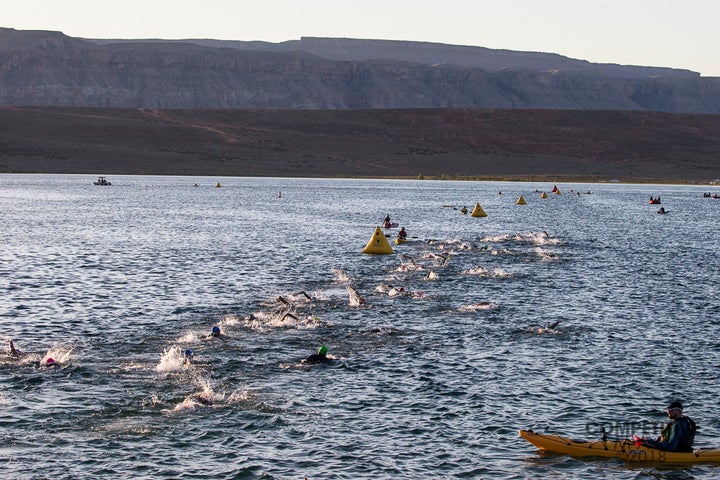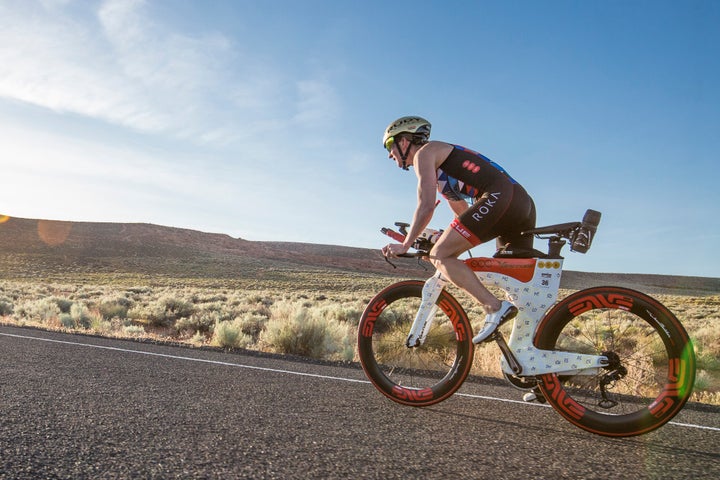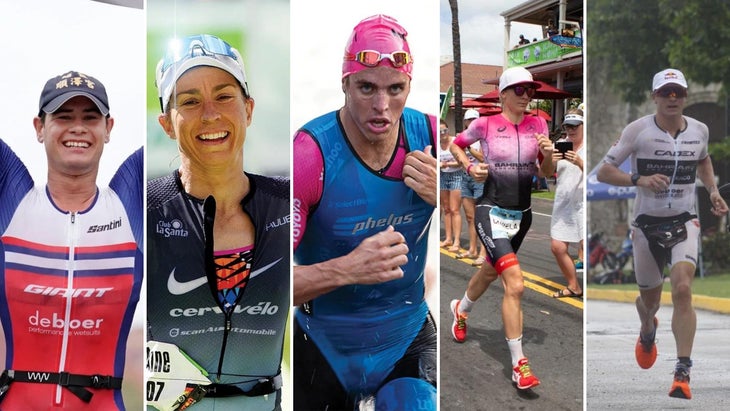How the St. George Course Will Create a New Race Dynamic
In the first Ironman World Championship since 2019, the pros will tackle a historic course: a world title contested outside of Hawaii. It’ll be tough, hilly, and stacked. What could happen?
New perk! Get after it with local recommendations just for you. Discover nearby events, routes out your door, and hidden gems when you sign up for the Local Running Drop.
A barren, rocky landscape, unpredictable conditions, and the world’s best triathletes everywhere you turn. After more than two years’ absence, the Ironman World Championship is blowing back into our lives like the trade winds of Hawaii.
But we’re not on triathlon’s hallowed Pacific island (at least, not yet). Instead, it’s St. George, Utah, for the sport’s first big long-course rumble of the year and the first time outside of Hawaii in the event’s 44-year history.
“It gives me chills to think how exciting this opportunity is,” said race director Judy Stowers. “I see such a remarkable opportunity for those who are choosing to participate at St. George. I’ve been in the industry 15 years and not found a community that has embraced Ironman in quite the same way. Triathletes are not going to forget this experience any time soon.”
Scheduled for May 7, there’s little excuse for triathletes not to hit the start line in peak condition—at the beginning of what’s bound to be a packed season. (This race, yes, in 2022, is technically the 2021 Ironman World Championship, while the October event will crown the 2022 victor.) It’s not just the timing or the pent-up energy of top names finally meeting—St. George also offers a challenging and true test as a fitting venue for a world title.
RELATED: Confused by the 2022 Ironman World Championship Calendar? We Got You
“I’ve raced every event they have held since 2010 with the exception of one year when I was injured, so it gets me excited to see it hosting the world championship,” said Ben Hoffman, the winner of Ironman St. George in 2012, the last time there was a full-distance race here. “This was a good solution to give the professionals a chance to race, and the course, conditions, and community are sure to make it a memorable event.”
So what can we expect from the Land of Endurance, as the region is calling itself?
RELATED: Everything You Need To Know About the Ironman St. George Course
Season Timings
While the earlier date might seem alien to those who typically plan their year for a fall crescendo, when you’ve waited this long, it’s just great to get one under way. And if there’s a lesson to be learned from the pandemic, it’s the need to adapt to race when the opportunity arises.
It’ll be hard to tell what shape the elites will be in, though. Some pros raced Ironman New Zealand in March and the African Championship in South Africa in April, and a few 70.3 tune-ups such as Oceanside and Texas, but most pros will also need to be plotting for a long season to follow—see our tips for how to tackle 2022’s packed schedule—and so few hands are likely to be shown before race day in Mary.
A Course Where Champions Are Made

As testament to how trying the course can be, there used to be a full-distance event in St. George (before it was halved to a 70.3). That final race in 2012 was an epic challenge: a 29% DNF rate, and winners Hoffman and Meredith Kessler finishing in a relatively slow 9:07:04 and 10:12:59, respectively. Undeterred, both are on the start list for a return.
The 2.4-mile swim in the Sand Hollow Reservoir is all but guaranteed to be wetsuit-legal with water temperatures dropping as low as 58 degrees F at that time of year—a contrast, of course, to Hawaii’s balmy 80 degrees F, where a lack of wetsuits can exacerbate slow swimmers’ deficits.
RELATED: Sand Hollow Reservoir Could Swallow You Whole
Yet the net result of fresh water versus salt water, and wetsuit versus swimskin could still see the first leg follow a similar pattern to championships of years past. As Lucy Charles-Barclay showed when breaking clear at the 70.3 Worlds in St. George last year, there’s still an advantage to be had, regardless of the water temps. At the front of the men’s race, expect Josh Amberger to have Olympic champion Alistair Brownlee tickling his toes, with the other Olympic champ Kristian Blummenfelt not too far adrift.
“The thing that’s probably at the front of everyone’s mind is our bike course,” Stowers said. “There are just two other Ironman events that have more climbing than this route. The majority of the harder climbs are in the second half of the race, so it’s going to be a test of the athletes to pace themselves before they head up into Snow Canyon.” On the upside, she said, “the views are second to none.”
RELATED: Snow Canyon is the Crown Jewel of Ironman St. George
Unlike the loneliness and severity of the Queen K, the St. George run is a two-lap out-and-back. For those familiar with the 70.3’s steep and brutal run, know that won’t be as much of an issue this May. “We’ve flattened out the run course for them,” Stowers said. “The September race had some big climbs, but we’re not doing that here.”
“Coming back in from the first lap there is close to a mile in town where spectators can see their athletes, which hasn’t happened before for this event. It gives athletes the extra energy they might need at that point in the run.”
Utah in May?

You pay your money, you take your chances. “It’s typically pretty hot with temperatures likely in the mid-90s,” Stowers said. “St. George is a desert, so it’s a dry heat. There’s not a lot of humidity, and although we can’t guarantee the wind, it should be fairly mild that time of the year.”
Hoffman thinks there might be a bit more variation—as anyone who raced through the massive storm at the 70.3 World Championship will tell you. “The weather component is different in the sense that Kona is windy, humid, and hot, with very few exceptions,” he said. “But St. George can be very unpredictable and could see anything from snow and torrential rain and lightning, to very hot, dry, and windy conditions. One final difference that could play a small role is that St. George sits at a higher elevation than Kona, although not extreme.”
RELATED: To Win Ironman St. George, One Must First Beat the Weather
Athletes who typically thrive in humidity might find some of that advantage removed. More poignantly, the conditions are likely to bring “bigger” athletes into the game more—über bikers, for instance. Canada’s Lionel Sanders and the “Big Unit” American Sam Long could come to the fore, and a lead into T2 could be more significant than in Hawaii.
The Contenders

Although top five from 2019 on both the men’s and women’s side originally planned to return, injuries and illness have taken quite a few of the big names out. Anne Haug still looks to defend her crown and Daniela Ryf aims for a fifth title, having looked invincible from 2015 to 2018. While Haug should relish the wetsuit swim and climbs on the bike, don’t expect her competitors to view the switch to St. George as hampering their chances either.
The men’s side is set up for a much-anticipated battle. While two-time champ Patrick Lange and defending champion Jan Frodeno are both out of the race, there are plenty with a pedigree at this venue, including reigning Ironman 70.3 world champion Gustav Iden and double Olympic gold medalist Alistair Brownlee. The Yorkshireman won over the middle distance here in 2017, on that occasion beating Sanders into second. Sanders then defeated the USA’s Long in an epic sprint here last year.
All will start—Long making his long-course world champs debut with fond memories from being 70.3 worlds runner-up to Iden on this course in the fall. Then, of course, there’s reigning Olympic champion Blummenfelt, who signaled his intent to become the first triathlete to win both titles in the same year with the fastest Ironman ever at Cozumel in November.
“St. George will suit strength athletes that are well-balanced and have shown top results at the big races and St. George in the past,” Hoffman said. “Aside from myself, I would look at Lionel, Sam, Sebastian [Kienle], Alistair, Gustav, as well as Braden [Currie], Bart [Aernouts], and Cameron [Wurf]. For the women, definitely Daniela, Anne, Heather [Jackson], and Kat [Matthews] could go well.”
In short: Both races are stacked. The course and weather will be tough. Someone we expect to win could take the tape, but then again we don’t know what exactly to expect. Buckle up. We usually have to wait until the end of the year for this kind of drama.
Ironman St. George World Championship Preview: Women’s Race
Ironman St. George World Championship Preview: Men’s Race
From March/April 2022
